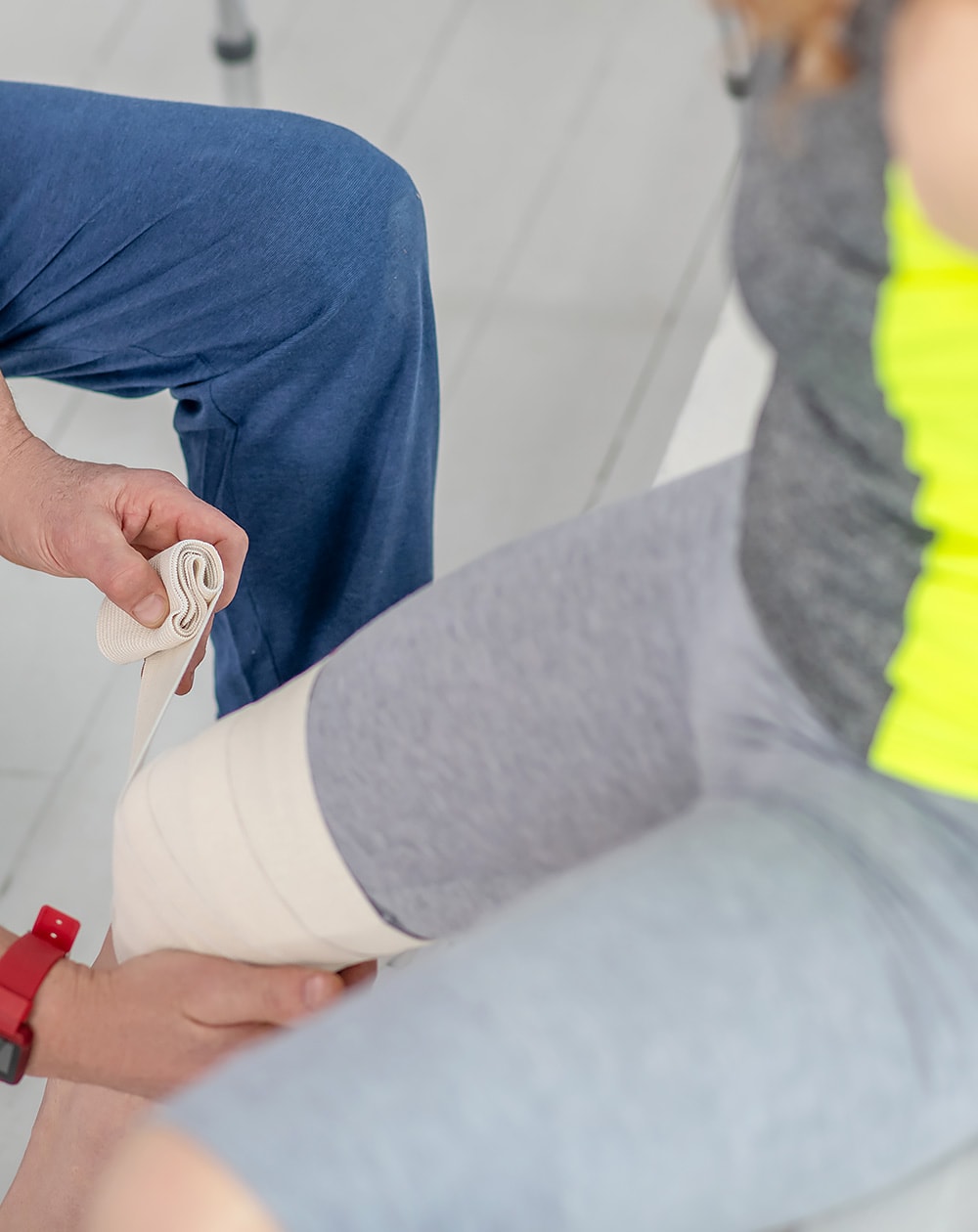Legs and thighs are vital for daily activities and routines, providing mobility, stability, and balance. They enable us to walk, run, stand, and perform tasks that require strength and flexibility. Injuries to these areas at work can have severe repercussions, impacting both physical and mental health.
When someone suffers an injury to their legs or thighs at work, it can impair their mobility, making it challenging to perform daily tasks and job duties. This limitation can lead to a loss of income and independence, as well as cause emotional distress. Recovery often involves extensive rehabilitation and may require time away from work, affecting financial stability. Overall, injuries to the legs and thighs affect physical health and have profound consequences on an individual's emotional well-being and quality of life.
However, a complete recovery is possible with the help of an experienced work injury doctor. At Spine and Joint Institute of Milwaukee, our compassionate medical professionals care about your health and well-being and will thoroughly examine your injury to develop a personalized treatment plan. All the while, our staff will properly document your treatment to build your most robust workers’ compensation claim. We know what you’re going through and will stop at nothing to help ensure a speedy recovery so you can get back to what you do best.
The timeline for a neck injury to heal can vary widely depending on the type and extent of the injury, and individual factors such as overall health and adherence to your treatment plan. Individuals with work-related leg or thigh injuries need to follow their healthcare provider's recommendations for treatment and rehabilitation to ensure optimal recovery and minimize the risk of long-term complications. Here are general timelines for some common neck injuries:
Resting the injured leg or thigh is often the first step in treatment. Immobilization may be achieved through splints, braces, or casts to prevent further injury and promote healing.
Applying ice to the injured area can help reduce pain, swelling, and inflammation. Ice packs or cold therapy devices may be used for short periods several times a day.
Compression bandages or wraps may be applied to reduce swelling and support the injured leg or thigh.
Elevating the injured leg or thigh above heart level can help reduce swelling by allowing fluid to drain away from the injured area.
Over-the-counter or prescription pain medications may be recommended to manage pain and discomfort associated with the injury.
Once the acute phase of the injury has passed, physical therapy exercises and rehabilitation may be prescribed to restore strength, flexibility, and range of motion to the injured leg or thigh.
Depending on the severity of the injury, assistive devices such as crutches, walkers, or canes may be necessary to help with mobility during the recovery process.
In cases of severe or complex injuries, surgery may be required to repair damaged tissues, stabilize fractures, or restore function to the leg or thigh.
Occupational rehabilitation programs may be recommended for work-related injuries to facilitate a safe return to work and help the individual regain job-specific skills and functions.
Common types of work-related leg and thigh injuries can include:
Strains and Sprains. These injuries occur when muscles, tendons, or ligaments in the leg or thigh are stretched or torn, often due to overexertion, repetitive motions, or sudden movements.
Fractures. Fractures, or broken bones, can occur in the bones of the leg or thigh due to falls, crush injuries, or traumatic impacts.
Contusions. Contusions, or bruises, can result from direct blows or impacts to the leg or thigh, causing damage to the underlying tissues and blood vessels.
Impingement Syndrome. This is when soft tissue, such as bursae and tendons, become compressed or pinched between bones or other structures in the body. This can cause pain, stiffness, and discomfort in the hip or groin area, which may worsen with specific movements or activities.
Tendonitis. Tendonitis involves inflammation or irritation of the tendons in the leg or thigh, typically due to repetitive movements or overuse.
Bursitis. Bursitis is inflammation of the bursae, small fluid-filled sacs that cushion and lubricate the joints. It can occur in the knees, hips, or other joints of the leg or thigh due to repetitive motion or prolonged pressure.
Strains. Strains involve overstretching or tearing muscles or tendons in the leg or thigh, often caused by sudden movements, lifting heavy objects, or awkward postures.
Work-Related trauma. Work-related trauma, such as crush injuries, falls from heights, or accidents involving heavy machinery or equipment, can result in various types of leg and thigh injuries, including fractures, lacerations, and soft tissue injuries.
Overuse Injuries. Overuse injuries, such as stress fractures, shin splints, or iliotibial band syndrome, can develop over time due to repetitive stress or strain on the leg or thigh muscles, tendons, or bones.
These are just a few examples of common work-related leg and thigh injuries. It's essential to take precautions to prevent such injuries by following proper safety protocols, using ergonomic equipment, and seeking prompt medical attention if an injury occurs.
Diagnosing a leg or thigh injury typically involves a combination of a medical history review, physical examination, and sometimes imaging tests. Here's a general overview:
Based on the findings from these steps, your doctor can make a diagnosis and recommend an appropriate treatment plan, which may include rest, physical therapy, medication, or, in some cases, surgery.
The potential for complete healing from a work-related leg or thigh injury depends on various factors, including the severity of the injury, the effectiveness of treatment, and individual factors, such as overall health and adherence to rehabilitation protocols. In many cases, with proper medical care and rehabilitation, individuals can achieve significant improvement and return to normal function. However, complete healing to the pre-injury state may not always be possible, especially in cases of severe trauma or certain chronic conditions.
Treatment for work-related leg or thigh injuries typically aims to reduce pain, restore function, and improve quality of life. Treatment may involve a combination of rest, physical therapy, medication, and, in some cases, surgery. It's essential to follow your healthcare provider's recommendations closely and actively participate in your recovery process to optimize the chances of achieving the best possible outcome.
In some instances, individuals may experience lasting effects or complications from a work-related leg or thigh injury, such as chronic pain, reduced range of motion, or disability. In these cases, ongoing medical management and rehabilitation may be necessary to manage symptoms and maximize function.
Additionally, laws and regulations regarding compensation and support for work-related injuries vary by location. It is essential that you know your rights and seek appropriate legal and financial advice if needed.

Remember that timely and appropriate medical care is essential for effectively managing leg or thigh injuries and promoting optimal recovery. Don't hesitate to seek professional medical advice if you're unsure about the severity of your injury or the best course of action. If you've injured your leg or thigh at work, it's essential to take the following steps:
Evaluate the extent of the injury. Determine if you can bear weight on the affected leg or thigh and assess the severity of pain, swelling, or any visible deformities.
If the injury is severe, or if you're unable to bear weight on the injured limb, seek prompt medical attention. Call emergency services or have someone take you to the nearest hospital or urgent care facility if necessary.
Report the injury to your employer as soon as possible, following your workplace's procedures for work-related injuries. This documentation is crucial for filing a worker's compensation claim.
If first aid is necessary, administer it according to established protocols. This may include applying ice, elevating the injured limb, and providing temporary immobilization with a splint or bandage.
Avoid putting weight on the injured leg or thigh and engaging in activities that could worsen the injury. Use crutches, a cane, or other assistive devices as needed to reduce strain on the injured limb.
Take over-the-counter pain relievers as directed by your healthcare provider to manage pain and discomfort. Applying ice packs to the injured area can also help reduce swelling and inflammation.
Follow any instructions your healthcare provider provides for home care, including rest, elevation, and rehabilitation exercises. Attend follow-up appointments as scheduled to monitor your progress and adjust your treatment plan as needed.
Keep your employer informed of your medical status and any limitations or accommodations needed for work duties. Work with your employer and healthcare provider to develop a plan for returning to work safely once you can.
Are you struggling with a leg or thigh injury sustained at work? At Spine and Joint Institute of Milwaukee, our clinic provides comprehensive care and support to help you recover and get back on your feet. We understand the unique challenges and concerns of work-related injuries, and our team of experienced healthcare professionals is dedicated to guiding you through every step of your rehabilitation journey.
From initial assessment to personalized treatment plans, our clinic offers various services tailored to your specific needs. With a focus on restoring function and promoting optimal recovery, our goal is to help you regain confidence and return to work safely. Don't let a work-related leg or thigh injury hold you back – schedule an appointment with our work injury clinic today and take the first step towards a healthier, pain-free future.
If you or a loved one has experienced leg or thigh trauma, contact Spine and Joint Institute of Milwaukee right away. Our team is here to provide the support and care you need to navigate the challenges of work-related injury recovery while documenting your treatment properly for your workers’ compensation claim. We work closely with our patients and help ensure a swift recovery, a stress-free workers' compensation claims process, and a safe return to work.

If you are not receiving proper care for your injury, you have the right under Wisconsin Workers' Compensation Law to choose your own doctor and to get a second opinion.